7 Business and Commerce
In the mid-1800s, Niles Centre was essentially an agricultural settlement, independent of the city of Chicago for the simple reason that roads and transportation were not yet a real part of the area’s way of life. This promoted the development of local businesses that catered directly to the needs and desires of the area residents.
The earliest businesses in Niles Centre reflected the settlement’s sense of self-sufficiency: agricultural products, greenhouses, horse trading, blacksmith shops, general stores, and saloons. But as early as 1834, John Miller introduced industry to the local area by building a sawmill on the North Branch of the Chicago River.
Henry Harms opened the first general store in Niles Centre in 1858, and another in 1862, the same year that Peter Bergmann opened one to offer a little competition. Peter Blameuser, Jr. made his commercial debut in 1865 by opening a clothing store that he later expanded into a general store. By 1868, George C. Klehm had bought one of Henry Harms’ stores, and in 1874 Fred Stielow opened Niles Centre’s first greenhouse.
Michael Harrer earned the distinction of becoming the first butcher in Niles Centre when he opened a meat market on Lincoln Avenue in 1874, and the first full-time barber, Robert E. Siegel, set up shop in 1893. George Busscher, Sr. unveiled his blacksmith shop in 1879, and seven years later found himself competing with two other shops owned by Peter Baumhart and Herman Gerhardt. By the mid-1880s, Niles Centre could claim five stores, three greenhouses, two meat markets, three blacksmith shops, and six saloons.
Banking came to Niles Centre in 1907 with the establishment of the Niles Centre State Bank, organized by Peter M. Hoffman and others, which would eventually evolve into the NBD Skokie Bank.
By 1909, George Busscher, Jr. had opened an eclectic store where a customer could buy anything from a horsedrawn buggy to a sewing machine to a can of paint. Two years later he went into partnership with Anthony Paroubek, with the result a merger that became known as the Niles Center Mercantile Company, which was located at what is today 8045 Lincoln Avenue. That diverse commercial outlet remains in business to this day at 5035 Oakton Street, although it operates now under the name Ace Hardware.
In 1915, Ivan M. Paroubek, Anthony’s brother, bought the village’s only bakery from John Seul. Situated at 8101 Niles Center Road, the bakery was moved in 1946 to 8044 Lincoln and remained in the hands of the Paroubek family until it was sold to Thomas Vitello in the 1980s.
By the advent of World War I, there were agriculturally oriented businesses in Niles Center run by Herbert Baumann, E.H. Blameuser, John C. Meier, Ludwig Schmitt, the Stielow brothers, Henry W. Bruns, Edwin T. Klehm, Stephen Losch, George W. Middlestaedt, and, of course, the Niles Center Mercantile Company. In addition, George H. Klehm sold insurance, Henry Heinz owned an auto dealership, the Tess brothers ran a grocery store, Medard M. Gabel had a hardware store, E.E. Cleland operated an ice cream shop, and August Siegel was in the cigar business.
In the 1920s, Armond King established his real estate business on Oakton Street. The first major office structure, the Bronx Building at Dempster and Bronx, was built. The National Bank of Niles Center, the townships’s first nationally chartered bank, was founded with Ferdinand Baumann as its first president.
Individual entrepreneurs also flourished. In 1925, Ambrose Brod founded the Niles Center Electric Shop, which still operates at its original site, 8021 Lincoln. Martin “Scotty” Krier, with his brother, opened a restaurant, which would became well known as Scotty and Pete’s, at 8014 Lincoln. Ray W. Haben launched the Haben Funeral Home at 8057 Niles Center Road in 1929, which is still owned and operated by the family at the same location.
After World War II, the influx was of larger businesses and corporate offices, but still small businesses thrived, especially in downtown Skokie. In fact, the downtown business district was highly regarded throughout the area as a fashion center with a variety of clothing stores.
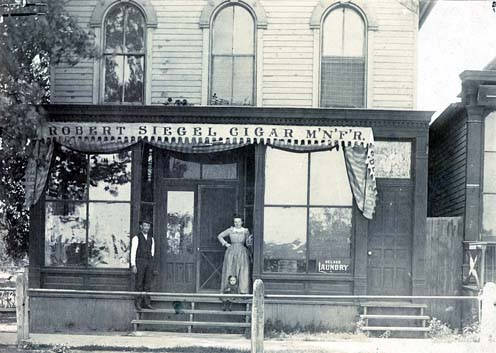 Siegal’s Cigar Store at 8022 Lincoln Avenue
Siegal’s Cigar Store at 8022 Lincoln Avenue
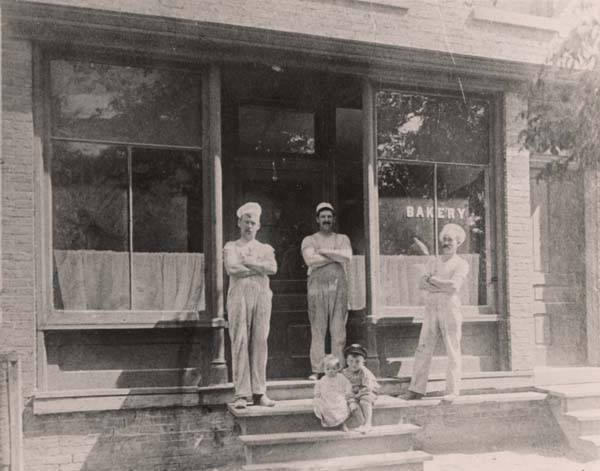 Paroubek’s Bakery about 1900, then at 8057 Niles Center Road
Paroubek’s Bakery about 1900, then at 8057 Niles Center Road
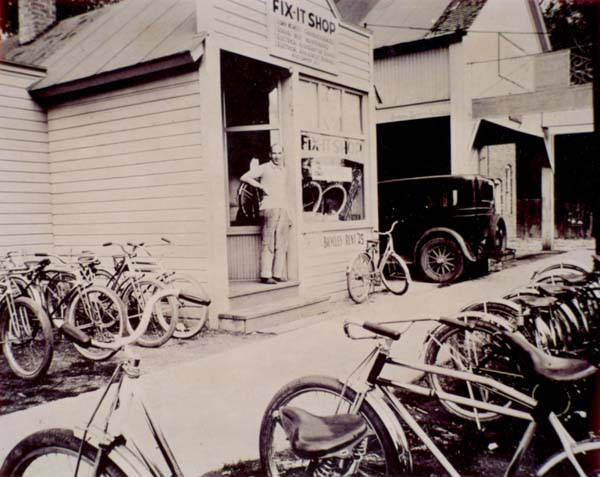 Fix-It Shop that apparently had plenty of bicycle business on Oakton just east of Lincoln
Fix-It Shop that apparently had plenty of bicycle business on Oakton just east of Lincoln
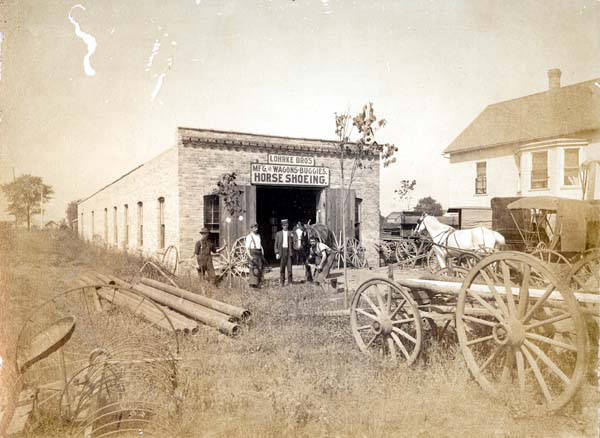 The Lohrke Bros. blacksmith shop on Niles Center Road just north of St. Peter’s Catholic Church about 1902
The Lohrke Bros. blacksmith shop on Niles Center Road just north of St. Peter’s Catholic Church about 1902
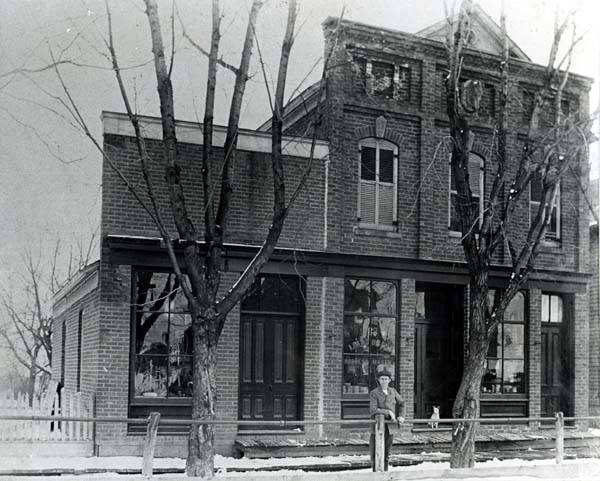 The Paroubek Harness Maker shop at 8045 Lincoln Avenue in 1898 (it is believed the man posing in front of it is Ivan Paroubek)
The Paroubek Harness Maker shop at 8045 Lincoln Avenue in 1898 (it is believed the man posing in front of it is Ivan Paroubek)
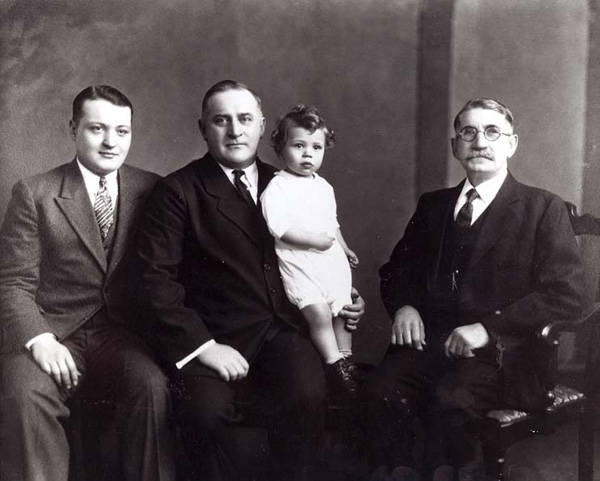 Four generations of the Busscher family, which was instrumental in the development of business in Niles Centre: left to right: George, III; George, Jr.; George D; George, Sr
Four generations of the Busscher family, which was instrumental in the development of business in Niles Centre: left to right: George, III; George, Jr.; George D; George, Sr
 Peter Blameuser’s business card
Peter Blameuser’s business card
 The northwest corner of Lincoln and Oakton circa 1930. At the far left of the picture is the National Bank of Niles Center
The northwest corner of Lincoln and Oakton circa 1930. At the far left of the picture is the National Bank of Niles Center
Corporate Neighbors
By the 1980s, Skokie was the home of more than 400 industrial and commercial corporations and corporate offices, a number of them nationwide leaders in their fields. Among the major business interests represented are pharmaceuticals, sporting goods, scientific and industrial equipment, video tapes, publishing, and electronics.
One of the first corporations in Skokie and certainly one of the most important, is G.D. Searle &
Company, which today employs about 2,000 people, more than any other business in Skokie. The huge pharmaceutical corporation came to the village from Chicago in March 1942. Although it was originally located on Searle Parkway and still maintains some operations there, the company’s new headquarters, two imposing glass and steel buildings, is located at 5200 Old Orchard Road. G.D. Searle’s yearly gross sales today are in excess of $800 million.
In 1944, Clarence Herbst organized Resinoid Engineering Corporation. The company produces heat- resistant plastic parts, provides additives for plastic molders, and does some custom molding jobs as well. Resinoid is located in a one-story brick building at 3445 Howard Street, employs roughly 110 people, and maintains plants in Ohio and England as well.
After the war, the first two companies to plant roots in Skokie were Wells Manufacturing Company and Wm. W. Meyer & Sons, Inc. Wells, a foundry that makes castings from molten metal, originally employed about 60 people with a 42,000-square foot plant. Today, the company’s buildings at 7800 N. Austin occupy about 10 times that amount of square footage and claim about 700 employees.
The Meyer company, a producer of air and bulk processing equipment, was originally founded by William W. Meyer in 1933 and moved to Skokie in 1946. Employing about 80 people today, its operations are in four adjacent buildings at 8261 Elmwood Avenue.
What was to be for many years Skokie’s largest employer, Teletype Corporation took up residence on Touhy Avenue in 1951. The enormous data communications company had at its peak more than 2,000 employees. Acquired by AT&T in the 1980s the company is now gone from Skokie. On its vast acreage and with its unique facilities, the Taxman Corporation and Trammell Crow Co. plans to develop a shopping and business district. Portland Cement also moved into the area in 1951, opening research laboratories on Harrison Street.
Rand McNally & Company, which has long held the distinction of being the world’s largest maker of road maps, came to Skokie in 1952. When the company settled down on Central Park Avenue back then, the Rand McNally building was surrounded by empty prairie. The original six-acre building was used largely for printing and warehousing the company’s publications. Over the years, Rand McNally also became a major trade book and educational publisher. It expanded its printing facilities to such a degree that that part of the operation eventually had to be moved to new quarters outside Skokie. The large Rand McNally complex remains at 8255 N. Central Park, serving as corporate headquarters and housing a wide range of editorial and cartographic operations.
That same year Allstate Insurance Company set up its Illinois Regional Operations Center in Skokie. The office was originally located in a building at 7447 Skokie Boulevard, but now occupies a handsome two-story complex at 7770 Frontage Road just off Edens Expressway. With about 650 employees in residence, the Skokie office coordinates the efforts of about 2,000 Allstate insurance agents and 2 million customers in six states (Illinois, Indiana, Minnesota, Wisconsin, North Dakota, and South Dakota).
One of the most significant additions to the Skokie commercial landscape also arrived in 1952, the Fel-Pro Corporation, one of the most community conscious companies to be found in any area. Fel-Pro, which manufactures automotive gaskets and sealers at 7450 McCormick Boulevard, donated the Fel-Pro Park, also on McCormick Boulevard, to the village. In addition, the company instituted Skokie’s first day-care program for employees with young children and supported an artist-in-residence program for the benefit of all of Skokie. By the late 1980s, Fel-Pro employment roster had grown to approximately 1,700.
In 1961, the Welch Company, a maker of scientific instruments and apparatus, relocated its operations from Chicago to Skokie. Seven years later, it merged with the Sargent Company, which was in the same relative field of endeavor, and the result was the Sargent-Welch Scientific Company. Today it is known nationwide for its high-tech products, such as electro-analytical devices, vacuum pumps, and instruments and apparatus that are used in physics and biology classrooms and laboratories throughout the country. Located at 7300 N. Linder, Sargent-Welch now employs about 700 people.
In the 1970s, Skokie witnessed the arrivals of the Brunswick Corporation, the North Shore Hilton Hotel, and the W.W. Grainger Company. Brunswick, perhaps best known for its bowling and billiards equipment, is, however, a broad-based company that manufactures a wide variety of marine and industrial products as well. Its offices in Skokie at 1 Brunswick Plaza serve as headquarters for two of the company’s divisions, Bowling Recreation Centers and Defense, and employ approximately 300 people. The North Shore Hilton, at the corner of Skokie Boulevard and Golf Road, opened its doors in 1973, and today has 368 rooms and suites. W.W. Grainger moved its corporate headquarters from Niles to Skokie in 1979, and currently resides on Howard Street just off Edens Expressway. The company, with sales of more than $1 billion annually, catalogs about 19,000 products, mostly in the areas of power and hand tools, heating and air conditioning equipment, and lighting materials.
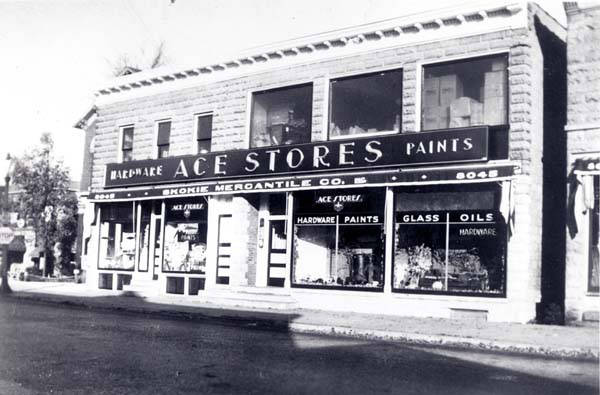 The Ace Hardware Store at 8045 Lincoln, which evolved from the Niles Center Mercantile Company
The Ace Hardware Store at 8045 Lincoln, which evolved from the Niles Center Mercantile Company
 Downtown Skokie looking north from the corner of Oakton and Lincoln (ca 1946)
Downtown Skokie looking north from the corner of Oakton and Lincoln (ca 1946)
![Modern Skokie business, represented here by the sculpture in front of the Fel-Pro Inc. building at 7450 McCormick Boulevard [Photo by Robert A Smith]](/assets/img/137a.jpg) Modern Skokie business, represented here by the sculpture in front of the Fel-Pro Inc. building at 7450 McCormick Boulevard [Photo by Robert A Smith]
Modern Skokie business, represented here by the sculpture in front of the Fel-Pro Inc. building at 7450 McCormick Boulevard [Photo by Robert A Smith]
![G.D. Searle & Co. buildings just off Edens Expressway at Old Orchard Road [Photo by Gerald Scott]](/assets/img/137b.jpg) G.D. Searle & Co. buildings just off Edens Expressway at Old Orchard Road [Photo by Gerald Scott]
G.D. Searle & Co. buildings just off Edens Expressway at Old Orchard Road [Photo by Gerald Scott]
Old Orchard Shopping Center
In October 1956, a little more than six years after the massive project was first announced by Hughston M. McBain, Chairman of the Board of Marshall Field and Company, Skokie’s Old Orchard Shopping Center opened its doors to visitors from all over the north suburbs and Chicago.
Although elegant shopping malls are now relatively commonplace, Old Orchard was the first in the area and remains one of the most famous and successful. Built on 100 acres of land just east of Edens Expressway, at Golf Road and Skokie Boulevard, the center features about 65 stores connected by stone concourses, and brightened by landscaping of trees and shrubs, seasonal flower gardens, sparkling fountains, pools and footbridges.
The shopping center was built by a subsidiary of the Aetna Life and Casualty Insurance Company of Hartford, eventually becoming known as the Urban Investment and Development Company, and by the parent company of Marshall Field, which has maintained ownership of the Marshall Field anchor store since the center opened.
In 1977, Urban Investment sold a 90 percent interest in Old Orchard to BKCG Private Acquisition Group Ltd. In June 1984, JMB Realty Corporation, one of the largest real estate syndication companies in the U.S., bought a majority interest in the shopping center for an undisclosed price.
The Old Orchard complex has approximately 1.2 million square feet of retail space and a seven-story, 60,000-square-foot office and administration building. Total retail sales in the 1980s have averaged close to $200 million annually.
Old Orchard Shopping Center, view of Montgomery Ward Store, 1985
Financial Institutions
The Niles Centre State Bank, founded in 1907, wove its way through the Roaring 20s, the Great Depression, World War II, and in the 1950s was known as the First National Bank of Skokie. It did not become the NBD Skokie Bank until 1987. With clearly the longest heritage of any financial institution in the village, it also lays claim to being the largest exclusively in Skokie with assets today in excess of $400 million. It employs more than 175 people, and is headquartered at 8001 Lincoln Avenue.
Competition for money in Skokie, however, became a vivid reality in the mid-1950s when three new financial institutions came to life.
First to come along was the Skokie Federal Savings and Loan Association in 1956, founded by John R. O’Connell, an attorney and the village’s police magistrate at the time. Over the next three decades, it grew to an organization with assets of $950 million, seven branches in the state of Illinois, and a varying total of about 230 full-time and 40 part-time employees. Its main offices are at 4747 Dempster in Skokie.
The following year, the Skokie Trust and Savings Bank opened its doors to the public, established by Joseph Hansen. In 1984, the institution joined the Cole Taylor Bank Group, and in 1987 changed its name to Cole Taylor Bank/Skokie. Today it has assets of about $173 million, employs 90 people, and is headquartered at 7700 Oakton. The Old Orchard Bank was launched in 1956, by a group made up of Lucius A. Andrew, Jr., Richard D. Culver, Russell H. Matthias, Alva W. Phelps, and Daniel C. Searle. It also underwent a name change, becoming the First American Bank in 1986. Approximately 70 employees handle its affairs today at 4949 Old Orchard Road, and the bank claims assets of about $141 million.
Since then, the village has added the Ben Franklin Savings & Loan Association, Citicorp Savings, Savings of America, St. Paul Federal, Talman Home Federal, and branches of the Eden Bank, the Bank of Lincolnwood, and the American National Bank.
Summing It Up
Besides the more than 400 commercial and industrial corporations residing in the village, Skokie can also lay claim to more than 1,000 retail stores, restaurants, and offices. Located in downtown Skokie, Old Orchard Shopping Center, the new Fashion Square Mall, and in other areas of the village, these establishments offer an enormous variety of goods and services not only to the citizens of Skokie but to those of the entire area surrounding it as well.
Henry Harms, the Blaumeuser’s, the Klehm’s, and the other pioneer merchants of the village would undoubtedly be more than mildly astonished to learn that Skokie’s retail sales in the late 1980s are more than $500 million annually, ranking 10th in the entire state of Illinois.
 Restaurants and saloons have always been an important part of Skokie history. Elliott’s Pine Log, just one of many, served customers at the corner of Howard and Skokie Boulevard from 1939 until its closing in 1988.
Restaurants and saloons have always been an important part of Skokie history. Elliott’s Pine Log, just one of many, served customers at the corner of Howard and Skokie Boulevard from 1939 until its closing in 1988.